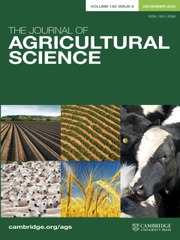No CrossRef data available.
Article contents
Dietary L-arginine for sows minimises the variability of piglets at birth
Published online by Cambridge University Press: 27 February 2025
Abstract

The objective of the trial was to evaluate the effects of arginine supplementation in the feed of gestating sows on the variability of piglet birth weight. The weight of the piglets was evaluated using descriptive analysis, correlation analysis and analysis of variance with a 2 × 3 factorial arrangement. This arrangement included no supplementation or supplementation with 1.0 % L-arginine, combined in three periods. Period 1: from days 25 to 53 of gestation, providing 23 g/day from days 25 to 28 and 18 g/day from days 29 to 53 of gestation; period 2: from days 30 to 60 of gestation and from day 80 of gestation to farrowing, providing 18 g/day in the first period and 45 g/day in the second period and period 3: from day 85 of gestation to delivery, with 24 g/day was provided from day 85 until farrowing and 28 g/day from days 85 to 107, increasing to 56 g/day from day 108 until farrowing. Supplementation with 1.0 % of L-arginine reduced the percentage of total piglets born and piglets born alive with less than 800 g by 2.26 and 2.05 percentage points, respectively; and increased the percentage of total piglets born and piglets born alive between 1601 and 1800g by 5.89 and 6.08 percentage points, respectively. Supplementing with 1.0 % of L-arginine improves litter uniformity, with an average reduction of 4.06 percentage points in the piglet population of less than 1180 g and an increase in the piglet population of 1180 to 1890 g by 4.70 percentage points.
- Type
- Animal Research Paper
- Information
- Copyright
- © Rennan Herculano Rufino Moreira, 2025. Published by Cambridge University Press



